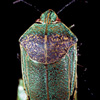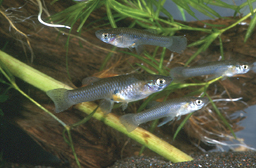
 GOOD GUYS & BAD GUYS
GOOD GUYS & BAD GUYS 

 |
 GOOD GUYS & BAD GUYS
GOOD GUYS & BAD GUYS 
|
 |
[Good Guys & Bad Guys Home | About This Site | Card List | HBS Home | Bishop Museum Home
BAD GUY  |
||
 |
42.
Western Mosquitofish
Gambusia affinis (western mosquitofish) has a maximum length
of 56 mm, and is always found in high densities in the lower stream reaches,
usually in the presence of another poeciliid fish, Poecilia mexicana.
The highest elevation at which Gambusia affinis has been found
was 185 m in Poliwai Gulch, near the Waiahole Ditch. Gambusia
affinis exhibits a wide salinity tolerance of 0 to 40 ppt, but is
usually found in areas having salinities of 16 ppt or less. Gambusia
affinis stomachs from Pearl Harbor streams were examined and found
to contain various aquatic fauna such as chironomids, shrimp, and ants.
Native damselflies were not found in these stomachs, but this was not
surprising because of the complete lack of native damselflies in all areas
where Gambusia affinis was found. |
|
| Photo by Ronald Englund | ||